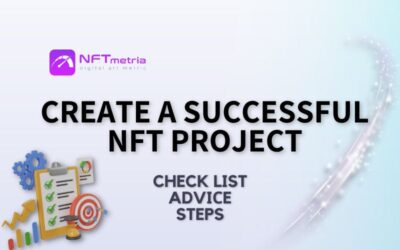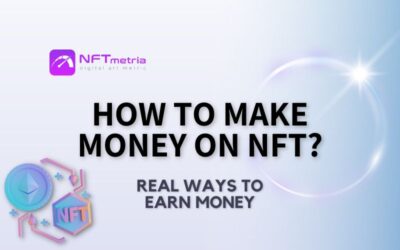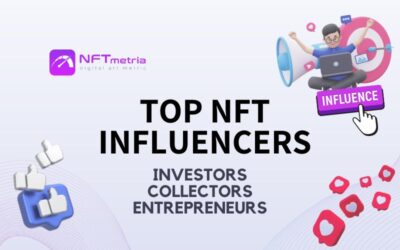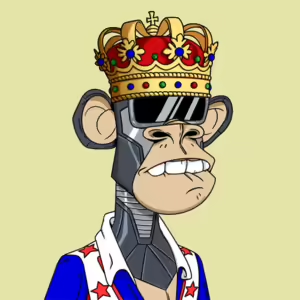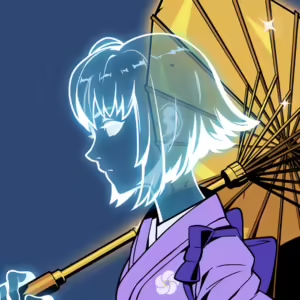In the rapidly evolving world of NFTs (Non-Fungible Tokens), where digital creativity meets blockchain technology, aspiring creators face a daunting challenge: standing out amid the ever-growing sea of NFT projects. With industry giants like Disney and NBA entering the NFT arena alongside individual artists and developers, the competition is fierce, and not every venture finds its footing.
Launching a successful NFT project goes beyond mere luck; it requires meticulous planning, technical expertise, and a deep understanding of the market dynamics. In this article, we delve into the essential steps and proven strategies that can guide you from conceptualization to a thriving NFT collection. Whether you’re a budding artist, an entrepreneur, or a seasoned developer, these insights will equip you with the knowledge to navigate the complexities of the NFT landscape.
What Makes an NFT Project Successful?
A successful NFT project is defined not only by the attention it garners upon release but also by its ability to maintain a high level of audience interest even after the official launch. Long-term engagement and fan activity become key indicators of success. But how do projects retain their audience and sustain interest over time?
Innovative and Unique Features
Successful NFT projects offer unique and innovative features that make their collections in-demand and distinctive. These features could include membership passes for exclusive events, early access to upcoming NFT releases, or the ability to use NFTs in games and other virtual worlds. These functionalities add value to NFTs and encourage participants to remain active.
Active Community Engagement
Successful projects actively engage with their communities. This involves not only keeping them informed about updates and events but also listening to feedback from participants. Understanding the audience’s needs and responding to their expectations creates interaction that keeps the project dynamic and interesting for participants.
Evolution and Growth
Successful NFT projects don’t rest on their laurels. They continuously evolve and introduce new opportunities. This could involve adding new collections, improving NFT functionality, or forging unique partnerships. The project’s evolution sustains participants’ interest and reaffirms its relevance.
Transparency and Trust
Projects that build their relationships with the audience on transparency and trust have a higher chance of success. This includes clear and straightforward communication, openness in relationships with participants, and keeping promises. Participants value long-term relationships and the demonstration of care for their interests.
Therefore, when creating an NFT project, it’s crucial to focus not only on the moment of token minting but also on how the project will develop and interact with the audience in the future. Innovations, community focus, and long-term plans play a decisive role in the success of an NFT project.
Steps to Create a Successful NFT Project
Creating a successful NFT project is a process that requires careful planning, a creative approach, and attention to detail. Here are some key steps that will help you create a popular and successful NFT project:
Research Your Target Audience and Create a Unique Product
The first step toward a successful NFT project is a deep understanding of your target audience. Explore their interests, tastes, and preferences. Create a unique product that not only aligns with these preferences but also inspires and captivates their imagination. For example, Bored Ape Yacht Club (BAYC) envisioned a future where crypto-millionaires have fun in an ape club. Chiru Labs introduced the Azuki project, capturing the hearts of anime enthusiasts. Find a concept that resonates with your audience.
Offer Unique Utilities and Privileges
Develop utilities and features that add value to your NFTs. These could be special privileges, intellectual property rights, or even the ability to use NFTs in “play-to-earn” games. Be open to new concepts and trends in the Web3 world to create innovative and unique opportunities for NFT owners.
In the current market, there are numerous successful NFT projects where a similar approach has been implemented:
- VeeFriends holders are entitled to a 3-year pass to the global IRL conference VeeCon, which excites the entire Web3 community every year.
- Clone X owners automatically enter the RTFKT ecosystem, qualifying for future drops and exclusive merchandise.
- PROOF Collective offers all members of their community exclusive access to insider information and Grails drops, featuring highly valuable and expensive digital assets.
Choose the Right Blockchain and Marketplace
One of the first and crucial steps in launching an NFT project is selecting the appropriate blockchain and marketplace. Most NFTs are created and traded on Ethereum (it’s worth noting that this blockchain has the highest transaction fees) and OpenSea (keep in mind that since August 31, 2023, the marketplace has disabled royalty support for creators). However, there are alternative blockchains and marketplaces that might be suitable for your project:
- OpenSea: The first and largest NFT marketplace.
- Blur: A relatively young and ambitious platform that launched its own token $BLUR and started with an aggressive approach toward the market leader, OpenSea.
- SuperRare: an NFT marketplace where mainly 1/1 NFTs are sold, featuring well-known NFT artists.
- Foundation: A curated NFT marketplace planning to build a new creative economy.
- Nifty Gateway: A curated NFT marketplace where collections and 1/1 NFTs of artists who already have a recognizable name are predominantly featured.
- Rarible: A community-owned marketplace that uses its own currency.
- WAX Digital: An NFT marketplace where exclusive NFTs from global brands and performers are published.
Selling NFTs from your own website gives you greater control over the process, allowing you to avoid high gas fees and providing more flexibility. However, this approach also requires more work, extensive marketing, and initial investments.
It’s also important to choose a blockchain that fits your needs. Ethereum is popular and has a large community, but there are alternatives such as Flow, Solana, Tezos, Cardano, and others. Dive into their specifics and choose one that aligns with your project’s strategy and vision.
Collaborate with Recognizable Artists
Capture the audience’s attention by collaborating with artists they respect and love. Such partnerships create an emotional connection and support from the community. When users see their favorite artist endorsing your project, they are inclined to invest in it.
Here are a few examples:
- Deekay: At the beginning of his NFT career, he collaborated with the renowned artist PAK. Together, they managed to release two recognizable works by Wizzard and Ronny.
- Cory Van Lew: Gained significant recognition in the industry after purchasing a series of three works from the artist FEWOCiOUS in March 2021.
Build a Community
An active and devoted community is a key aspect of a successful NFT project. Engage with your fans through social media, organize contests and events, create exclusive content for community members. Community support helps foster loyalty and sustains interest in your project.
Here are a few examples:
- FEWOCiOUS: The artist has a strong and extensive fan community that supports every initiative. He remains in constant contact with the community on social media.
- Bryan Brinkman: Engages with his audience, partly due to having his animation school, which fosters interaction and community involvement.
Develop Long-Term Partnerships and Collaborations
Establish long-term partnerships and collaborations with other NFT projects, artists, brands, and organizations. Partnerships can create mutual benefits and increase the visibility of your project. Consider the following steps:
- Explore Potential Partners: Research other NFT projects and artists that might be suitable for collaboration. Consider their style, values, and community to ensure they align with your project.
- Create Unique Collaborations: Develop unique and interesting ideas for joint projects. These could include joint NFT collections, interactive events, or even virtual exhibitions. Creative ideas will capture attention and provide a unique experience for participants.
- Establish Mutually Beneficial Terms: Discuss partnership terms that will be beneficial for all parties involved. This could involve profit-sharing from sales, exchanging NFTs between projects, or joint marketing initiatives. Clear terms will help avoid misunderstandings and conflicts.
- Maintain Long-Term Relationships: After establishing a partnership, maintain long-term relationships. Regularly communicate with your partners, discuss new ideas, and continue joint projects. Stable relationships can lead to future collaborations.
- Publicize and Promote Partnerships: Share your partnerships with your community and a wider audience. Use social media, public statements, and press releases to announce joint projects. Visibility will help spread awareness of your project.
Successful and productive partnerships can significantly increase interest in your project, attracting new participants and NFT collectors.
Typically, this is the most costly and expensive method, but it is almost guaranteed to lead you to success.
Here are a couple of examples:
- Deekay: Gained massive recognition after his LIFE AND DEATH NFT was acquired by Cozomo de’Medici (Snoop Dogg‘s pseudonym in the crypto world) for 1 million dollars.
- Cory Van Lew: Created a joint collection with Mike Tyson, which not only brought him fame but also substantial earnings.

Work with Professionals
If you are unsure about your skills in design, development, or marketing, don’t hesitate to seek help from professionals. Partnering with experienced artists, developers, and marketers will help you create a high-quality product and effectively promote it.
Consider collaborating with marketing agencies specializing in Web3. Hiring a marketing consultant or agency with experience in Web3 will help you engage effectively with your audience. Alternatively, assemble your own team of public relations experts to interact actively with your community members.
Craft a Unique Narrative
Every successful NFT project has a captivating story behind it. Share the origins of your collection, inspiring moments, and what makes your project unique. A compelling story gives your project a soul and helps participants emotionally connect with it.
A shining example is the World of Women NFT collection. The project aims to expand women’s rights and opportunities by promoting diversity and gender inclusivity in an industry where women represent only a small fraction of NFT artists. It became the first prominent project in the NFT space to realize this vision.
Create a Powerful Roadmap
To sustain interest in your project post-launch, offer users more than just the NFTs themselves. For instance, create unique applications accessible to NFT owners in the future. Plan the project’s development in the long term by designing NFTs that evolve, provide utility, and increase in value over time.
For example, Doodles aims to become one of the largest consumer brands in the world. Ambitious, isn’t it? However, as we can see, the team is taking diverse and effective steps towards this goal.
Set a Fair Price and Royalties
Carefully determine the mint price of the NFTs to avoid undervaluing their worth and maintain community interest. Establish reasonable royalties to ensure NFT owners receive fair profits upon their resale.
Take Care of Quality
The quality of your NFTs is paramount. Ensure that the graphics are high-resolution, animations are smooth, and details are meticulously crafted. High quality builds trust among buyers and enhances the value of your tokens.
Plan the Economic Model
Develop a clear economic model for your project. Decide how the proceeds from NFT sales will be distributed and what privileges long-term token holders will receive. Transparency in the economic model enhances trust in the project.
Support Innovation and Evolve
Keep an eye on trends in the world of NFTs and Web3. Be ready to implement new technologies and features in your project. Innovations can give your project a competitive edge and attract those looking for something unique and ahead of its time.
Conclusion
The guide “How to Become a Successful NFT Project: Essential Steps for a Flourishing Project” has provided you with a deep insight into the world of unparalleled digital assets. We have explored the key steps and methods that make an NFT project anticipated and in demand in this dynamic industry.
Your journey to success starts here, with a profound understanding of your audience’s values and a high-quality product. An NFT project is not just a collection of tokens; it’s art, community, and innovation blended together. We have examined every stage of project creation, from audience research and collaboration with artists to the development of unique features and the crafting of an economic model.
Now that you are equipped with knowledge and confidence, we encourage you to look ahead and bring your ideas to life. The guide has been your compass, and now it’s time to embark on a journey through the world of unique NFT projects.
Join our NFT artists’ gallery and let your creativity soar. This is your chance to be a part of the future of art that is reshaping the world.
Contact us now and begin your exciting journey into the universe of NFTs!

